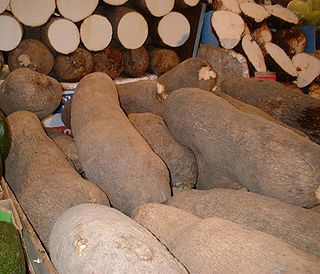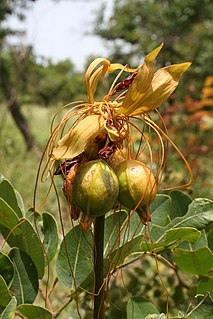
Dioscorea alata, also known as purple yam, ube, or greater yam, among many other names, is a species of yam. The tubers are usually a vivid violet-purple to bright lavender in color, but some range in color from cream to plain white. It is sometimes confused with taro and the Okinawa sweet potato, although D. alata is also grown in Okinawa where it is known as beniimo (紅芋). With its origins in the Asian tropics, D. alata has been known to humans since ancient times.

Dioscorea is a genus of over 600 species of flowering plants in the family Dioscoreaceae, native throughout the tropical and warm temperate regions of the world. The vast majority of the species are tropical, with only a few species extending into temperate climates. It was named by the monk Charles Plumier after the ancient Greek physician and botanist Dioscorides.

Eddoe or eddo is a tropical vegetable often considered identifiable as the species Colocasia antiquorum, closely related to taro, which is primarily used for its thickened stems (corms). In most cultivars there is an acrid taste that requires careful cooking. The young leaves can also be cooked and eaten, but they have a somewhat acrid taste.

Yam is the common name for some plant species in the genus Dioscorea that form edible tubers. Yams are perennial herbaceous vines cultivated for the consumption of their starchy tubers in many temperate and tropical regions, especially in Africa, South America and the Caribbean, Asia, and Oceania. The tubers themselves, also called "yams", come in a variety of forms owing to numerous cultivars and related species.
Kokoro is a 1914 novel by Natsume Sōseki.

Àmàlà is a local indigenous Nigerian swallow food, native to the Yoruba ethnic group in the western states of the country. It is made out of yam and/or cassava flour, or unripe plantain flour. Yams are peeled, sliced, cleaned, dried and then blended into a flour, also called èlùbọ́. Yams are white in colour but turn brown when dried. This gives àmàlà its colour. Àmàlà is from Western Africa and eaten mostly by the Yoruba people in Nigeria. Amala is mainly consumed by indigenous people of the Southwestern part of Nigeria. It could be served with a variety of ọbẹ (soups), such as ẹ̀fọ́, ilá, ewédú, ogbono or gbẹ̀gìrì.

Dioscorea polystachya or Chinese yam, also called cinnamon-vine, is a species of flowering plant in the yam family. It is sometimes called Chinese potato or by its Japanese name nagaimo.

Dioscorea bulbifera is a species of true yam in the yam family, Dioscoreaceae. It is native to Africa, Asia and northern Australia. It is widely cultivated and has become naturalized in many regions.

Diosgenin, a phytosteroid sapogenin, is the product of hydrolysis by acids, strong bases, or enzymes of saponins, extracted from the tubers of Dioscorea wild yam, such as the Kokoro. The sugar-free (aglycone) product of such hydrolysis, diosgenin is used for the commercial synthesis of cortisone, pregnenolone, progesterone, and other steroid products.

Dioscorea esculenta, commonly known as the lesser yam, is a yam species native to Island Southeast Asia and introduced to Near Oceania and East Africa by early Austronesian voyagers. It is grown for their edible tubers, though it has smaller tubers than the more widely-cultivated Dioscorea alata and is usually spiny.

Tacca leontopetaloides is a species of flowering plant in the yam family Dioscoreaceae. It is native to Island Southeast Asia but have been introduced as canoe plants throughout the Indo-Pacific tropics by Austronesian peoples during prehistoric times. They have become naturalized to tropical Africa, South Asia, northern Australia, and Oceania. Common names include Polynesian arrowroot, Fiji arrowroot, East Indies arrowroot, and pia.

Dioscorea cayenensis subsp. rotundata, commonly known as the white yam, West African yam, Guinea yam, or white ñame, is a subspecies of yam native to Africa. It is one of the most important cultivated yams. Kokoro is one of its most important cultivars.

Nigeria is by far the world’s largest producer of yams, accounting for over 70–76 percent of the world production. According to the Food and Agriculture Organization report, in 1985, Nigeria produced 18.3 million tonnes of yam from 1.5 million hectares, representing 73.8 percent of total yam production in Africa. According to 2008 figures, yam production in Nigeria has nearly doubled since 1985, with Nigeria producing 35.017 million metric tonnes with value equivalent of US$5.654 billion. In perspective, the world's second and third largest producers of yams, Côte d'Ivoire and Ghana, only produced 6.9 and 4.8 million tonnes of yams in 2008 respectively. According to the International Institute of Tropical Agriculture, Nigeria accounted for about 70 percent of the world production amounting to 17 million tonnes from land area 2,837,000 hectares under yam cultivation.

Dioscorea pentaphylla is a species of flowering plant in the yam family known by the common name fiveleaf yam. It is native to southern and eastern Asia as well as New Guinea and northern Australia. It is widely cultivated as a food crop and naturalized in Cuba and on several island chains in the Pacific.
Helen Nosakhare Asemota is a biochemist and agricultural biotechnologist based in Jamaica. She is Professor of Biochemistry and Molecular Biology and Director of the Biotechnology Centre at the University of the West Indies at Mona, Jamaica. Her research develops biotechnology strategies for production and improvement of tropical tuber crops. She is notable for leading large international biotechnology collaborations, as well as for acting as an international biotechnology consultant for the United Nations (UN).

One of the major human migration events was the maritime settlement of the islands of the Indo-Pacific by the Austronesian peoples, believed to have started from at least 5,500 to 4,000 BP. These migrations were accompanied by a set of domesticated, semi-domesticated, and commensal plants and animals transported via outrigger ships and catamarans that enabled early Austronesians to thrive in the islands of Maritime Southeast Asia, Near Oceania (Melanesia), Remote Oceania, Madagascar, and the Comoros Islands.
Dioscorea praehensilis is a species of yam in the genus Dioscorea native to Africa. It is the wild progenitor of the West African domesticated crops Dioscorea rotundata and Dioscorea cayennensis. It is a liana with an edible tuber root found in African rainforests and seasonal tropical forests. The roots reach their maximum starch reserves during the dry season. The species renews its stems every year at the start of the rainy season.
Dioscorea cayenensis is a species of yam in the genus Dioscorea that is a widely consumed West African domesticated crop. Dioscorea rotundata is sometimes treated as a subspecies, and sometimes also as a separate species. Common names include Guinea yam, yellow yam, and yellow Guinea yam.












